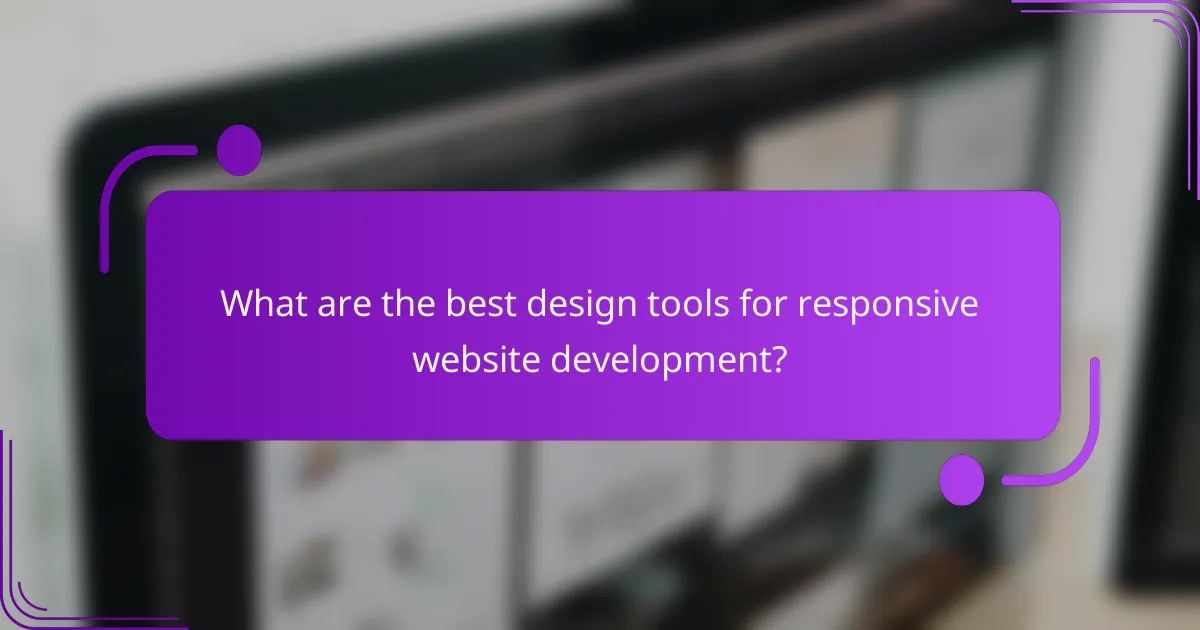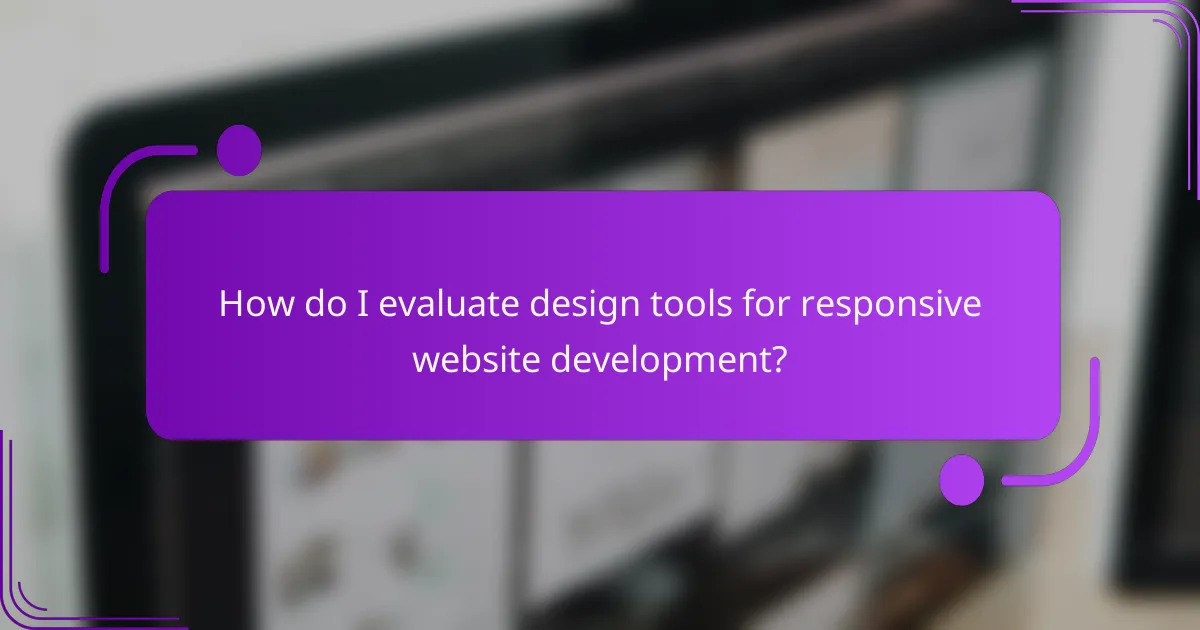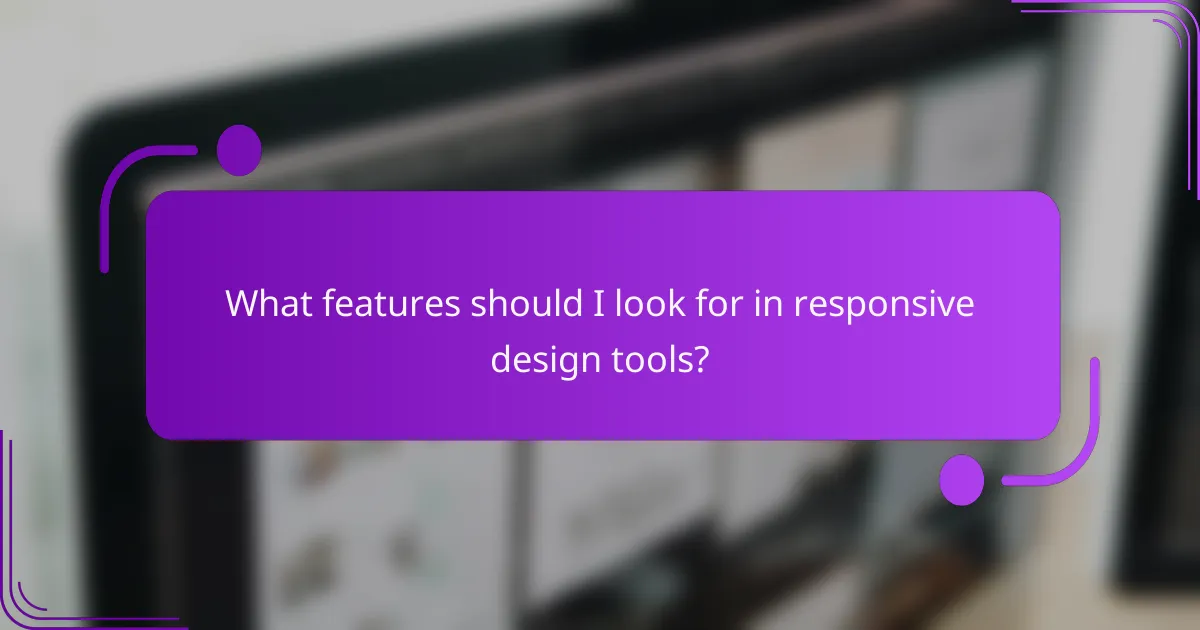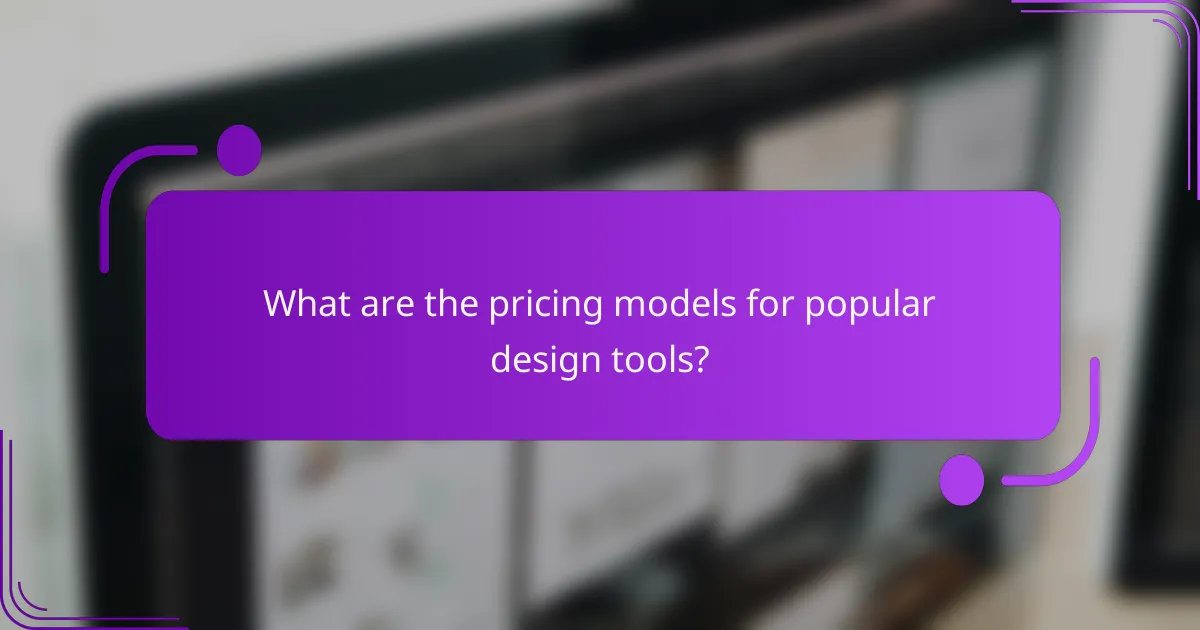In the realm of responsive website development, choosing the right design tools is essential for creating adaptable and user-friendly interfaces. Key evaluation criteria include features that enhance collaboration, usability, and integration capabilities, which collectively streamline the design process. Popular tools like Figma, Adobe XD, and Webflow offer unique functionalities that cater to various design needs, making them valuable assets for any designer aiming to optimize their workflow.

What are the best design tools for responsive website development?
The best design tools for responsive website development are those that facilitate collaboration, streamline workflows, and support various screen sizes. Popular options include Figma, Adobe XD, Sketch, Webflow, and Bootstrap Studio, each offering unique features and usability for designers.
Figma
Figma is a cloud-based design tool that excels in real-time collaboration, making it ideal for teams. It allows users to create responsive designs with ease, utilizing components and constraints to adapt layouts for different screen sizes.
Key features include vector editing, prototyping, and design systems. Figma’s community resources provide templates and plugins that can enhance productivity and creativity.
Adobe XD
Adobe XD is a powerful tool for designing and prototyping user experiences. It offers features like responsive resize, which automatically adjusts design elements based on screen dimensions, making it easier to create adaptive layouts.
Integration with other Adobe Creative Cloud applications allows for seamless workflows, while its sharing capabilities facilitate feedback and collaboration. Adobe XD also supports voice prototyping and animation, adding depth to user interactions.
Sketch
Sketch is a vector-based design tool that has been a favorite among web designers for years. It provides a robust set of features for creating responsive designs, including symbols and shared styles that ensure consistency across projects.
While primarily Mac-based, Sketch offers a range of plugins that extend its functionality, allowing for integration with various design systems and tools. However, its lack of built-in collaboration features may require additional tools for team projects.
Webflow
Webflow combines design and development in a single platform, allowing users to create responsive websites visually without writing code. Its intuitive interface enables designers to build layouts that automatically adjust to different screen sizes.
Webflow also includes hosting and CMS capabilities, making it a comprehensive solution for launching websites. Users can utilize pre-built templates or start from scratch, and the platform supports custom animations and interactions for enhanced user experiences.
Bootstrap Studio
Bootstrap Studio is a drag-and-drop builder specifically designed for creating responsive websites using the Bootstrap framework. It provides a library of components that can be easily customized to fit design needs.
This tool is particularly useful for developers familiar with Bootstrap, as it streamlines the process of building responsive layouts. Users can export clean HTML and CSS code, making it easy to integrate designs into existing projects.

How do I evaluate design tools for responsive website development?
To evaluate design tools for responsive website development, focus on their feature set, usability, and integration capabilities. These criteria will help you identify tools that enhance your workflow and produce effective, adaptable designs.
Feature set comparison
When comparing feature sets, consider essential functionalities such as grid systems, pre-built templates, and design elements that support responsiveness. Look for tools that offer flexible layouts and customization options to accommodate various screen sizes.
Additionally, assess the availability of collaborative features, version control, and design handoff capabilities. Tools that integrate with popular design systems or frameworks can significantly streamline your development process.
Usability testing results
Usability testing is crucial for understanding how intuitive a design tool is for users. Look for tools that have received positive feedback in user testing, particularly regarding ease of navigation and learning curve.
Consider tools that provide comprehensive tutorials, community support, and documentation. A tool that is easy to use can save time and reduce frustration during the design process.
Integration capabilities
Integration capabilities determine how well a design tool works with other software in your workflow. Check if the tool can seamlessly connect with content management systems (CMS), version control systems, and other design tools.
Tools that support API integrations or have plugins for popular platforms can enhance functionality and improve collaboration among team members. Ensure that the tool you choose can fit into your existing tech stack without significant adjustments.

What features should I look for in responsive design tools?
When selecting responsive design tools, prioritize features that enhance collaboration, prototyping, responsive previews, and support for design systems. These elements are crucial for creating adaptable websites that function well across various devices and screen sizes.
Collaboration tools
Effective collaboration tools allow teams to work together seamlessly, sharing designs and feedback in real-time. Look for features like comment threads, version control, and integration with project management software to streamline communication.
Consider tools that offer cloud-based access, enabling team members to collaborate from different locations. This flexibility can significantly enhance productivity and ensure that everyone is on the same page during the design process.
Prototyping capabilities
Prototyping capabilities are essential for testing design concepts before full implementation. A good responsive design tool should allow you to create interactive prototypes that mimic user interactions across devices.
Evaluate tools based on their ease of use and the variety of prototyping options they offer, such as low-fidelity wireframes or high-fidelity mockups. This will help you choose a tool that fits your workflow and meets your project needs.
Responsive previews
Responsive previews enable designers to see how their work will appear on different screen sizes and orientations. Look for tools that provide real-time previews across various devices, such as smartphones, tablets, and desktops.
Some tools even allow you to simulate different operating systems and browsers, which can help identify potential issues early in the design process. This feature is vital for ensuring a consistent user experience across platforms.
Design systems support
Support for design systems is crucial for maintaining consistency across your projects. Choose tools that facilitate the creation and management of design systems, including reusable components and style guides.
Effective design systems can streamline the development process and improve collaboration between designers and developers. Look for tools that integrate with popular design systems or allow for easy customization to fit your specific needs.

How do usability and user experience impact design tools?
Usability and user experience are critical factors that influence the effectiveness of design tools for responsive website development. A tool that is easy to use and provides a positive experience can significantly enhance productivity and creativity, while a poor user experience can lead to frustration and inefficiency.
User feedback mechanisms
User feedback mechanisms are essential for understanding how design tools perform in real-world scenarios. These can include surveys, usability testing, and analytics that track user interactions. Gathering feedback helps identify pain points and areas for improvement, ensuring that the tool evolves to meet user needs.
When evaluating design tools, look for those that incorporate user feedback loops, such as built-in survey features or direct feedback options. This allows users to share their experiences and suggestions, fostering a community-driven approach to tool enhancement.
Learning curve analysis
The learning curve of a design tool can significantly affect its adoption and overall user satisfaction. A steep learning curve may deter users, while tools that are intuitive and easy to learn can lead to quicker implementation and better results. Consider how much time users typically need to become proficient with the tool.
To assess the learning curve, look for resources such as tutorials, documentation, and community support. Tools that offer extensive learning materials and user-friendly interfaces tend to have lower barriers to entry. Aim for tools that allow users to start creating quickly while still offering advanced features for deeper exploration as they gain experience.

What are the pricing models for popular design tools?
Popular design tools typically offer various pricing models, including subscription-based pricing, one-time purchase options, and free tiers. Understanding these models helps users choose the right tool based on their budget and needs.
Subscription-based pricing
Subscription-based pricing is common among design tools, allowing users to pay a recurring fee, often monthly or annually. This model provides access to the latest features and updates without the need for large upfront costs.
Prices for subscription plans can range from around $10 to $50 per month, depending on the tool and the features included. Users should consider whether they need advanced functionalities or team collaboration options, which may influence the subscription tier they choose.
One-time purchase options
One-time purchase options allow users to pay a single fee for perpetual access to the software. This model can be appealing for those who prefer not to commit to ongoing payments.
Prices for one-time purchases typically range from $50 to $500, depending on the tool’s capabilities. However, users should be aware that this option may not include future updates or support, which could lead to additional costs down the line.
Free tier availability
Many design tools offer a free tier, providing limited access to features at no cost. This option is ideal for individuals or small teams looking to test a tool before committing financially.
Free tiers often come with restrictions, such as limited storage, fewer templates, or watermarked exports. Users should evaluate whether the limitations of the free version meet their needs or if upgrading to a paid plan is necessary for their projects.
